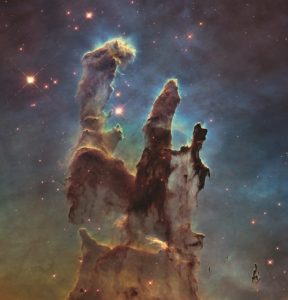The full moon you see rising in the east now actually rose 1.3 seconds ago. That’s how long it takes sunlight reflecting off the lunar surface to reach Earth. If extraterrestrial teenagers were to extinguish the Sun as some kind of interstellar prank, we would not know it for eight minutes — the time it would take for the last of the Sun’s light to travel the 93 million miles to Earth.
Look for the constellation Orion in the south after sunset. Do you see the bright red star that forms the hunter’s right shoulder? That’s Betelgeuse. Its light began its journey to your eyes about 500 years ago, when the art, music, and literature of Ming China flourished, and Shakespeare wrote his great works. The Betelgeuse we see is a centuries-old snapshot, continually updating every moment as newer photons arrive.
The speed of light is 186,282 miles per second. Which means there is always some interval of time between the emission or reflection of light from a given object and our visual perception of it. We can never see things as they are right now. Our visual world is always history.

To describe astronomical distances, we use the term light-year: the distance light travels in one Earth year, or about 6 trillion miles.
The Andromeda Galaxy, visible to the unaided eye from your back yard as a faint fuzzy patch, is two million light-years away (that’s 11,757,251,082,496,821,000 miles) and appears to us as it was two million years ago, when sabre-toothed tigers prowled the landscape of the Pleistocene epoch.
This curious consequence of light’s finite speed may give rise to any number of philosophical crises, but it is a great gift to astronomers. It allows them to study the past as no other science can. Imagine that you could look out from Provincetown Harbor and see the Mayflower dropping anchor offshore, or look towards Boston from Race Point and see the mile-high glacier that ended at your feet 20,000 years ago. That’s what astronomers do when they point telescopes at distant objects. And the larger the telescope, the farther back in time they can see.
The Hubble Space Telescope was launched in 1990 to observe space from above Earth’s atmosphere. It saw farther than any telescope ever had before. Because of that, astronomers were able to test theories and make new discoveries, while the public enjoyed the beautiful images produced, many of which endure in popular culture, such as the Pillars of Creation.
And in December 1995, Hubble did something especially awe-inspiring. Ground controllers aimed it at a seemingly empty patch of sky and let it collect light for nearly six days. (Your iPhone taking photos in Night Mode uses an exposure time of a few seconds.) The resulting image, now called the Hubble Deep Field, revealed thousands of extremely faint, previously invisible galaxies. Among them were galaxies at distances of over 12 billion light-years, some of the farthest ever detected at that time. The universe itself is about 13.8 billion years old. Hubble Deep Field revealed to us a universe in its infancy, just beginning to form the grand structures that we can observe today much closer to us.
Now Hubble is nearing retirement. Its successor is the James Webb Space Telescope (JWST), which launched on Christmas Day this past December. JWST is poised to look even deeper into the past — to the very limits of the observable universe.
Astronomers are excited about the things they expect to see and mysteries they hope to solve, and maybe even more so for the unexpected: the data that overturn previous assumptions, or startling discoveries that point the way to a new understanding of our universe.
None of this comes free. Development of JWST over 25 years cost nearly $9 billion. Science operations over the next five years will cost another $860 million. That’s a lot of taxpayer money. Is it worth it? Aren’t there more important things to spend that money on?
Fair questions. I could contrast JWST with other expensive government endeavors. The F-35 Lightning jet fighter comes to mind. Defense Dept. figures are not easy to parse, but conservative estimates of the development and procurement costs total $400 billion; add well over another trillion to sustain the program over its estimated 50-year cycle, according to Forbes magazine. Or we could consider oil industry tax subsidies. How do you feel about forgiving these companies over $20 billion of tax every year? That’s the Brookings Institution’s estimate.
What price do we put on Hubble’s Pillars of Creation, its breathtaking image of Messier 104, or the profound knowledge we’ve gained? How do we estimate the price of JWST’s contributions to come? What is the value of inspiration? Beauty? Understanding?
I, for one, am glad to pay my own small share of JWST’s cost. And I look forward to the new wonders it will reveal to us. Clear skies!



